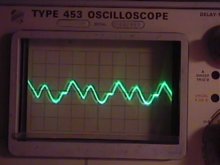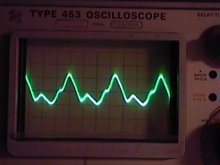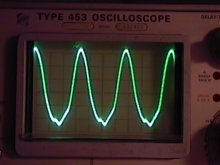Phase 45 Waveform Study
By Paul Marossy
Last
Updated 8/18/04
After building my Phase 45 clone, I became preoccupied with how phasers work for a week or two. One day, I thought it might be interesting to see
what happens to a sine wave input into the circuit with an oscilloscope. It was quite fascinating to see the phase dance that happens in this circuit.
The waveforms shown below are with the Phase 45 speed control set at 11:00 with a sine wave input at a frequency of 600Hz with 20dB attenuation. The
scope used is an old workhorse, a Tektronix 453. Time/Div was set at 1ms and
Volt/Div was set at 1V. Slope was set at "+". Below are some pictures of
the waveforms that I saw. These are what they look like at the output of
the circuit. I will try to get a video clip of this sometime, since that best shows how dramatic the phase dance is.
This is what it looks like when it sounds least affected. The amplitude dips a little lower than what is shown here,
I just didn't click the button
on the camera fast enough to catch it.
Here is the first distinct change in amplitude. Every other peak is rising while the other ones in between are diminishing.
I think there is actually three different peaks in the waveform, but it seems that one of those peaks
doesn't rise or fall very much. It's kind of hard to tell if all three
peaks alternate or not.
The peaks start to fall and the other peaks in between are now starting to rise. It's quite fascinating to watch this thing undulate.
Then, there is a second distinct change in amplitude, this one larger than the first. I never noticed this with my ears until I looked at it with a scope, and there is two different amplitudes of "swoosh", you can really tell when you are looking at it with a scope while listening to it.



